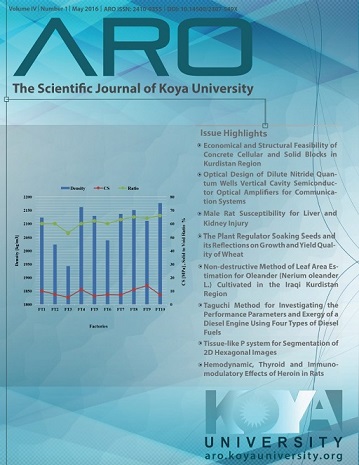Optical Design of Dilute Nitride Quantum Wells Vertical Cavity Semiconductor Optical Amplifiers for Communication Systems
DOI:
https://doi.org/10.14500/aro.10076Keywords:
Amplifier, Al(Ga)As, gain, GaInNAs, VCSOA.Abstract
III-V semiconductors components such as Gallium Arsenic (GaAs), Indium Antimony (InSb), Aluminum Arsenic (AlAs) and Indium Arsenic (InAs) have high carrier mobilities and direct energy gaps. This is making them indispensable for today’s optoelectronic devices such as semiconductor lasers and optical amplifiers at 1.3 μm wavelength operation. In fact, these elements are led to the invention of the Gallium Indium Nitride Arsenic (GaInNAs), where the lattice is matched to GaAs for such applications. This article is aimed to design dilute nitride GaInNAs quantum wells (QWs) enclosed between top and bottom of Aluminum (Gallium) Arsenic Al(Ga)As distributed bragg mirrors (DBRs) using MATLAB® program. Vertical cavity semiconductor optical amplifiers (VCSOAs) structures are based on Fabry Perot (FP) method to design optical gain and bandwidth gain to be operated in reflection and transmission modes. The optical model gives access to the contact layer of epitaxial structure and the reflectivity for successive radiative modes, their lasing thresholds, emission wavelengths and optical field distributions in the laser cavity.Downloads
References
Adams, M.J., Collins, J.V. and Henning, I.D., 1985. Analysis of semiconductor laser optical amplifiers. IEE Proc. J., 132(1), pp.58-63.
Aissat, A., Nacer, S., El-Bey, M., Guessoum, A., Ferdjani, K., Berkani, D. and Vilcot, J.P., 2007. The effect of nitrogen on the energy gap of a structure with strained quantum well containing GaInNAs/GaAs. Iranian J. of Elect. and Comp. Eng., 6(2), pp.169-161.
Buyanova, I.A., Chen, W.M. and Monemar, B., 2001. Electronic properties of Ga(In)NAs alloys. MRS Internet J. Nitride Semicond. Res., 6(2), pp.2.
Björlin, E.S., Kimura, T. and Bowers, J.E., 2003. Carrier-confined vertical cavity semiconductor optical amplifiers for higher gain and efficiency. IEEE J. Select. Topics Quant. Elect., 9(5), pp.1374-1385.
Coldren, L.A, Corzine, S.W. 1995. Diode lasers and photonic integrated circuits, NY: Wiley, New York.
Kondow, M., Uomi, K., Niwa, A., Kitatani, T., Watahiki, S. and Yazawa, Y., 1996. GaInNAs: A novel material for long-wavelength-range laser diodes with excellent high-temperature performance. Jpn. J. Appl. Phys., 35(1), pp.1273-1275.
Laurand, N., Calvez, S., Dawson, M.D., Bryce, A.C., Jouhti, T., Konttinen, J. and Pessa, M., 2005. Performance comparison of GaInNAs vertical cavity semiconductor optical amplifiers. IEEE J. Quant. Elect., 41(5), pp.642-649.
Lindsay, A. and O’Reilly, E.P., 1999. Theory of enhanced bandgap non parabolicity in GaNx As1-x and related alloys. Solid State Communication. 112(8), pp.443-447.
Piprek, J., Björlin, E.S. and Bowers, J.E., 2001. Design and analysis of vertical-cavity semiconductor optical amplifiers. IEEE J. Quant. Elect., 37(1), pp.127-134.
Piprek, J., Bjorlin, E.S. and Bowers, J.E., 2001. Optical gain-bandwidth product of vertical cavity laser amplifiers. Elect. Letts., 37(5), pp.298-299.
Shan, W., Walukiewiez, W., Ager, J.W., Haller, E.E., Geisz, J.F., Friedman, D.J., Olson J.M. and Kurtz, S.R., 1999. Band anticrossing in GaInNAs alloys. Phys. Rev. Lett., 82(6), pp.1221.
Skierbiszewski, C., Perlin, P., Wišniewski, P., Knap, W., Suski, T., Walukiewicz, W., Shan, W., Yu, K.M., Ager, J.W., Haller, E.E., Geisz, J.F. and Olson, J.M., 2000. Large, nitrogen-induced increase of the electron effective mass in InyGa1 - yNxAs1 – x . Appl. Phys. Lett. 76(17), pp.2409-2411.
Sun, Y., Balkan, N., Erol, A. and Arikan, M.C., 2009. Electronic transport in n- and p-type modulation-doped GaInNAs/GaAs quantum wells. Microelect. J., 40(30), pp.403-405.
Downloads
Published
How to Cite
Issue
Section
License
Authors who choose to publish their work with Aro agree to the following terms:
-
Authors retain the copyright to their work and grant the journal the right of first publication. The work is simultaneously licensed under a Creative Commons Attribution License [CC BY-NC-SA 4.0]. This license allows others to share the work with an acknowledgement of the work's authorship and initial publication in this journal.
-
Authors have the freedom to enter into separate agreements for the non-exclusive distribution of the journal's published version of the work. This includes options such as posting it to an institutional repository or publishing it in a book, as long as proper acknowledgement is given to its initial publication in this journal.
-
Authors are encouraged to share and post their work online, including in institutional repositories or on their personal websites, both prior to and during the submission process. This practice can lead to productive exchanges and increase the visibility and citation of the published work.
By agreeing to these terms, authors acknowledge the importance of open access and the benefits it brings to the scholarly community.
Accepted 2016-05-11
Published 2016-04-06
















 ARO Journal is a scientific, peer-reviewed, periodical, and diamond OAJ that has no APC or ASC.
ARO Journal is a scientific, peer-reviewed, periodical, and diamond OAJ that has no APC or ASC.